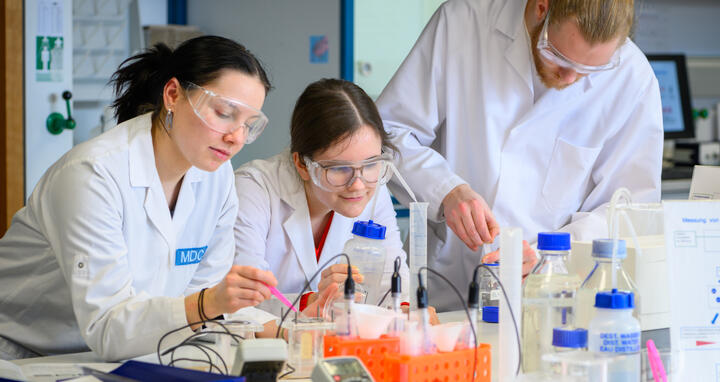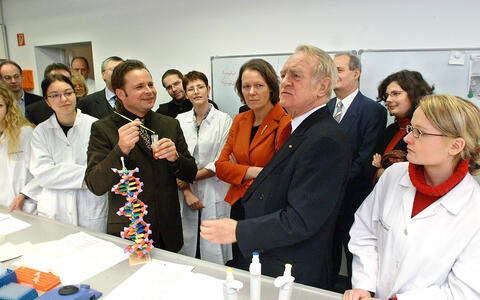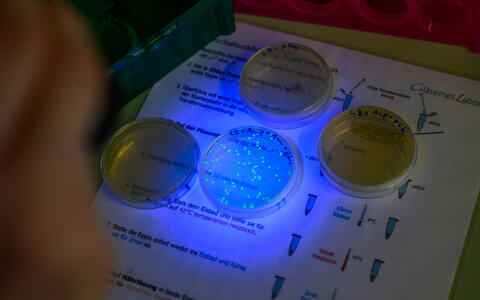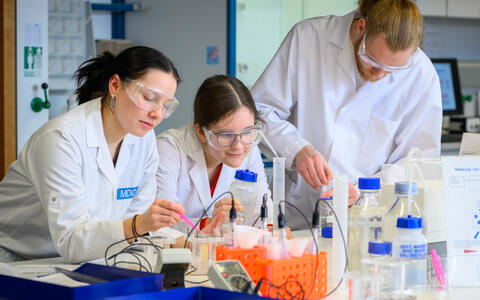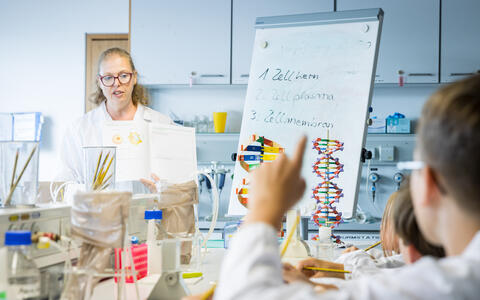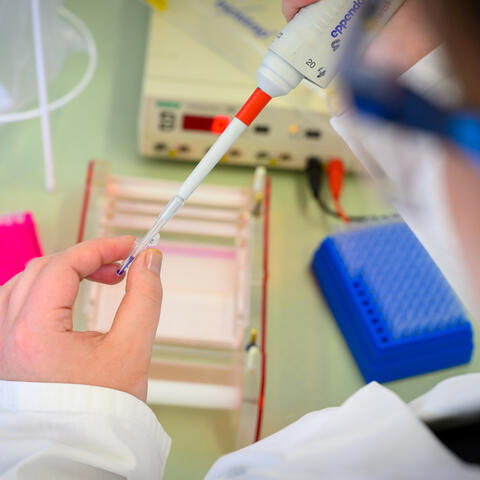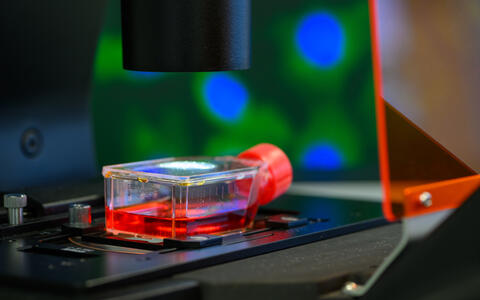25 years of the Life Science Learning Lab
A white coat is more than just a protective garment, it is a symbol, Claudia Jacob, head of the Life Science Learning Lab at the Berlin-Buch research campus, has often observed. Each year, some 14,000 school students and teachers visit the learning laboratory in the lush campus in the northern part of Berlin. “They take on a different role when they put on their lab coats,” Claudia Jacob says. “Their curiosity seems to be awakened in an instant.”
Federal President Johannes Rau and his wife together with Ulrich Scheller and schoolgirls in the life science learning lab.
In the late 1990s, Professor Detlev Ganten, founding director of the Max Delbrück Center, wanted to establish an information center to keep citizens abreast of developments in genetic engineering and biotechnology. The aim was for visitors to be able to look over the shoulders of scientists working in the lab. But Dr. Ulrich Scheller, then head of the public relations team at Campus Berlin-Buch GmbH (CBB) and now one of its managing directors, argued that merely observing scientists was not enough. “If you want to get people excited about research, you have to give them a chance to work with pipettes and test tubes,” Ulrich Scheller says. And so the concept was revised.
In April 1999, after three years of renovation, the Life Science Learning Lab opened its doors as a student lab in the old carriage house on the research campus.
More than 20 different experimental courses
In the beginning, students could participate in only four molecular genetics experiments. Today, 25 years later, there are six laboratories in all, making it one of the largest facilities of its kind in Germany. The CBB runs the Life Science Learning Lab together with the Max Delbrück Center and the Leibniz-Forschungsinstitut für Molekulare Pharmakologie (FMP); they are supported by numerous sponsors and partners, including the campus-based company Eckert & Ziegler, a provider of isotope technology for medical, scientific and industrial use. Together, they offer more than 20 experimental courses covering topics such as molecular biology, cell biology, neurobiology, chemistry, radioactivity and ecology.
Student experiment “Glowing bacteria” in the cloning course.
“We are one of the few student labs in Germany where young people can conduct experiments with CRISPR-Cas9 gene scissors,” remarks Ulrike Mittmann, scientific leader of the Molecular Biology Laboratory. Since molecular biology involves working with cells and pathogens or genetically modifying organisms, labs must adhere to strict safety regulations. Schools, however, are not able to abide by such regulations. Consequently, the facility serves more as a vehicle for exposing young people to current research topics.
Something for all ages
Structure of the Ussing chamber for measuring membrane potentials.
The Forschergarten at the Life Science Learning Lab also caters to young children of elementary school and kindergarten age. Moreover, there are working groups for school students, vacation courses, lectures and laboratory courses to prepare students for college. Teachers attend professional development sessions to learn about newly designed courses in the Life Science Learning Lab. In the “Lab meets Teacher” format, the Max Delbrück Center also offers teachers insights into current research topics and methods, such as single-cell analysis and Artificial Intelligence in biomedicine.
Together with the Max Delbrück Center, the FMP and the Experimental and Clinical Research Center, the Life Science Learning Lab organizes the regional competition “Jugend forscht” Berlin-Brandenburg – most recently in February of this year. A total of 95 school students presented their projects at the Max Delbrück Communications Center and were given a tour of the research facilities and the Student Lab on the campus during the supporting program.
“Fostering young talent is the primary goal of the Life Science Learning Lab,” comments Ulrich Scheller. “In addition to providing basic knowledge for all, we also support high-achieving school students to prepare them for a career in science or the life sciences sector.” After all, young talent is in short supply everywhere, including research labs. That is why it is important to encourage young people to train or to study in this field, says Ulrich Scheller. His co-managing director Dr. Christina Quensel adds: “We want to show young people that researchers do not focus on abstract issues that no one else understands, but that their work affects society as a whole.”
That is why ethical issues are also on the agenda. For example, why are animal experiments necessary, why should we be particularly cautious about stem cell therapies, and what does a genetic fingerprint reveal about a person? Both researchers and students benefit from this face-to-face interaction. “It is important that scientists occasionally come down from the ivory tower of basic research and explain their work in a way that is easy to understand,” says Christina Quensel. “Many a scientist has chosen to change careers to teaching after such an experience.”
Experience hands-on what biology is all about
To develop the course content, the Life Science Learning Lab team works closely with teachers from four partner schools in Berlin. They help the lab staff prepare research topics to fit the framework curriculum. “It takes a lot of effort for teachers to come to us with their class,” Ulrich Scheller explains. “They have to inform parents, collect money and take the train to Berlin-Buch. That means we have to give them something they can use for their classes.”
Laboratory manager Claudia Jacob explains microscopy results.
When Claudia Jacob welcomes new students to her neurobiology class, she does just that. She has them put on special glasses and lets them play with various balls in the foyer of the Max Delbrück Communications Center. Ripples of laughter fill the room. The glasses change the angle of vision, making throwing and catching virtually impossible – this is what it feels like when our brains and nervous systems are not in sync. “Starting the class in this way sparks curiosity in the subject,” says Claudia Jacob.
Experimentation makes science much easier to understand. Through lab work, biology becomes not just a school subject, but the science that teaches us how an organism works. “It’s like soccer,” says Ulrike Mittmann, putting it in a nutshell. “Even if you can recite all the rules and know in theory that the ball has to go into the net, that doesn’t make you a world champion. The only way to become a world champion is to actually sprint across the field.”
Consequently, hands-on experience is a top priority in the Life Science Learning Lab. How much caffeine is in cola, how scented oils are extracted from plants, how long it takes for a nerve impulse to travel from the brain to the big toe – these are just some of the things students learn under the guidance of Claudia Jacob and her colleagues. At the end, they present their results to the class. The content of the course is not set in stone, and new things are being added all the time. Dr. Bärbel Görhardt, scientific leader of the Chemistry Laboratory, is currently designing two new courses: one on dyes in algae and how they can be extracted, and another on enzymes, which act as catalysts to initiate or accelerate various chemical reactions in the body.
Single-cell sequencing, virtual reality and AI
Loading an Agarose gel.
“In the future, we would like to link the activities of the Life Science Learning Lab more closely to current research on campus,” says Professor Maike Sander, Scientific Director and Chair of the Board of the Max Delbrück Center. One of the primary goals is to introduce students to innovative technologies such as single-cell sequencing and new imaging techniques.
Budding researchers are always guaranteed placement in a course – perhaps not always in person, but in the form of short videos. In these videos, students explain their own experiments, which are not so dissimilar to those in the Life Science Learning Lab. “This allows young people to see that their experiments are close to real research,” says Maike Sander. New media is also being used more extensively: Students can wear virtual reality goggles to see inside a human heart, for example. “When they see a misfolded protein with their own eyes and observe the chain reaction that occurs, they can better understand how this affects the function of the heart,” explains Maike Sander.
As part of its graduate program, the Max Delbrück Center has launched a communications course in which doctoral students produce explainer videos and animations for the Life Science Learning Lab. In addition, the Max Delbrück Center plans to provide digital workbooks and teaching materials for schools.
The FMP is also keen to focus more on current scientific and technological developments. “One exciting area is Artificial Intelligence, where we want to develop projects that allow students to understand the basics of AI and where we see areas of application in our research,” explains Professor Dorothea Fiedler, Director of the FMP.
Lab leaders of the Life Science Learning Lab would also like to see more digitization of their work. Students could receive work instructions on tablets and store and share their results in the cloud, for example. New media also offer great opportunities for microscopy, comments Ulrike Mittmann: “Looking at your own blood cells not just through an eyepiece, but on a large screen – and then taking the image home as a screensaver on your smartphone – that would be awesome!”
How science works
Cell culture under the inverted microscope.
Inspiring a passion for research is important to everyone involved, including Paola Eckert-Palvarini, member of the Supervisory Board of Eckert & Ziegler SE. She initiated not only the Forschergarten, but also the Radioactivity Laboratory. “Radioactivity has a bad reputation in Germany,” remarks the radiation physicist, “out of ignorance.” She wants to put an end to that. In addition to conducting experiments, she also passes on practical knowledge. Natural radiation is everywhere: “There is cosmic radiation from space, radioactive elements and rocks in the ground emit radiation, as do certain foods and even we humans.” This natural background radiation is not a health hazard.
However, radiation generated and used in industry and medicine, such as when controlling the thickness of sheets of manufactured paper or in treating cancer, can be dangerous. But “because we can measure radioactivity, we can use it wisely and protect ourselves from it,” explains Paola Eckert-Palvarini, who is also interested in communicating how research works and what it takes to keep research results from disappearing into a drawer. The scientist is also an entrepreneur. “Research is not just about standing in a lab and chasing your own dream,” she says. “It is also about putting discoveries and inventions to work for people.”
That includes patents and licenses, as well as starting up companies. The students sometimes ask her lots of questions about these issues. “Of all the things I do, the student courses are the most rewarding,” she remarks. “Afterwards, I go home feeling like I’ve really done something worthwhile.”
Taking the Life Science Learning Lab to the heart of Buch
After 25 years in existence, the Life Science Learning Lab is now poised to grow beyond the boundaries of the research campus. In the new Education and Integration Center, to be built on the open space at Groscurthstraße 21-33 in the center of Berlin-Buch, it will operate three laboratories – “not quite as technically sophisticated as the laboratories on campus, but more suitable for families, where children can be introduced to scientific topics in a playful way,” explains Ulrich Scheller.
This development places the Life Science Learning Lab in the heart of Berlin-Buch – the location of future innovation, where it will take on another task for society as a whole: Teaching people of all ages how science works. This includes showing them that it is part of normal scientific discourse for researchers to hold different views.
“In research, many different paths lead to the goal,” notes Christina Quensel. “And it can happen that new knowledge turns everything we thought we knew upside down. We want to share this future euphoria with the public.” Dorothea Fiedler is of the same opinion: “We do not just want to communicate knowledge, but also to stimulate curiosity and foster the ability to apply and question scientific methods.” Claudia Jacob also considers this important – “especially in this day and age when so many skeptics of science are coming on the scene and spreading their alternative truths.” Putting on a lab coat and assuming the role of researcher can help us all to form an informed opinion.
Text: Jana Ehrhardt-Joswig / CBB

